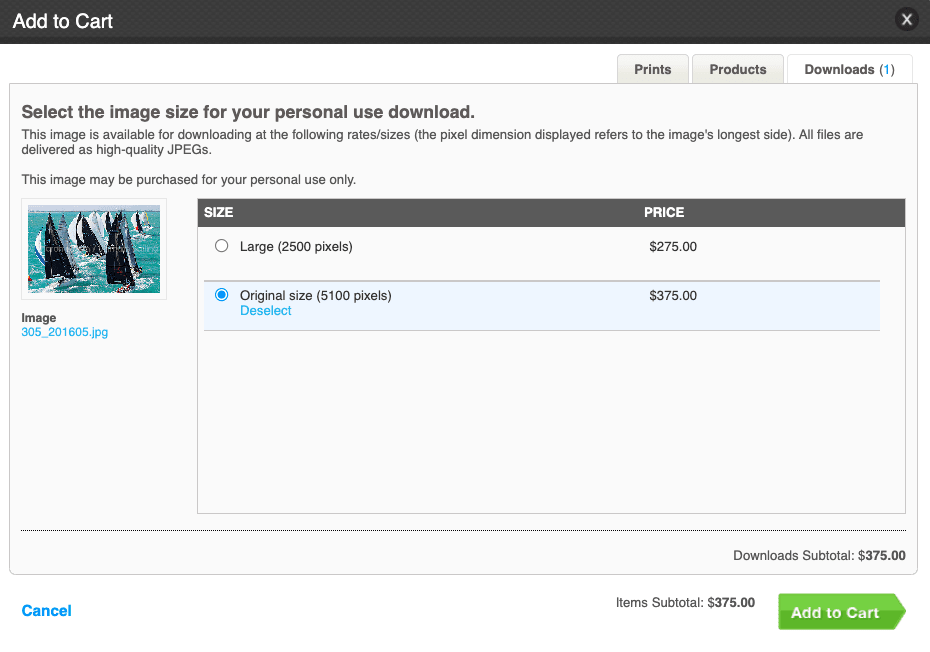Share
Diversify Your Photo Business with Digital Download Sales
Nowadays, photos are more likely to be delivered, distributed and viewed as digital downloads. Learn what types of images should be sold as downlo...

Despite the proliferation of smartphones and inexpensive digital cameras, retail photography – photos commissioned by consumers for personal use – has never gone away. School portraits, prom photos and wedding images benefit with the skill of an experienced photographer. And equipment like professional strobes will always be out of reach for the average consumer.
In the past, a nominal sitting fee was augmented by print sales. School photographers often offered a variety pack of images ranging from wallet size to 8×10 to simultaneously simplify purchasing decisions while also increasing their revenue per customer. Nowadays, however, photos are more likely to be delivered, distributed and viewed as digital downloads.
This change in consumer behavior has altered the way photographers price and deliver their images. Selling digital downloads has become a necessary and lucrative mechanism for image delivery.
What types of images should be sold as downloads?
In theory, any image can be sold as a download. You could offer an award-winning landscape photo that took you five years to make as a download, but in our estimation, this would be a mistake. Why?
Because an image with broad appeal that took considerable effort to create has greater value than an image of a specific, non-famous person like a senior portrait, headshot, or wedding image. The beautiful landscape image could potentially fetch hundreds or thousands of dollars, whereas the same is unlikely to be true for a retail photo.
Personal images work great as digital downloads. And PhotoShelter allows you to automate the sales and delivery process.

If I sell a digital download, can the buyer do whatever they want with it?
No. When you sell a download, what you are really doing is selling a license with the image. A license can restrict how the image is used. For example, personal use image downloads sold through a PhotoShelter account automatically have licensing language:
“By purchasing the selected photographs (the “Images”) you hereby agree and acknowledge that you are not acquiring any right, title or interest in or to the Images(s) or any associated copyrights, other then the right to possess, hold and use the Images(s) for personal, non-commercial purposes. Furthermore, you agree that you will: (i) not scan, copy, duplicate, distribute or otherwise reproduce the Images(s), (ii) not use the Images for any commercial purpose, without the express written consent of the photographer”
This isn’t to say that you’ll automatically be able to police someone who breaks the license. But the reality is that personal images have limited commercial value, and you probably don’t want to police petty infractions like if a family member reposts an image to their social media account.
Note: You can also sell Rights-Managed and Royalty-Free licenses with PhotoShelter if you’re looking for more specific licensing terms not offered by personal use downloads.
What size image should I deliver?
Professional digital cameras commonly deliver files ranging from 20MP to 100MP+. But consumers often run into file handling problems when dealing with very large images ranging from storage to scaling issues.
Most cell phones and tablets top out around 2500 pixels wide, while average consumer monitors range from about 2000 to 4000 pixels. For this reason, we suggest delivering files around 3000 pixels wide.
Of course, customer feedback and use case might ultimately influence the file sizes you deliver. For instance, if your buyer is purchasing this download for use on Facebook, they’d be best served with an image size of at least 1200px (on the image’s longest side).
Here are the image size requirements for some of the most popular social platforms:
- Facebook: 1200x630px
- Instagram: 1080×566-1350px
- LinkedIn: 400x400px
- Twitter: 1024x512px
- Pinterest: 1024x512px
- The Knot: 1891x918px

What should I charge?
Pricing can be a complex topic. Price too high, and you could lose sales. Price too low, and you leave money on the table. Your photography business undeniably has capital and operating expenses, and your revenue is contingent upon charging fees for services and photos.
Your local market will also influence what you can charge. Suffice it to say, if you are not charging a fee for taking photos (e.g. sitting fee, event fee, etc.), then you’ll need to charge more for the download to recoup your time and expense.
Another way to consider the issue is to come up with a target “average revenue per customer.” This might lead you to offer discounts for multiple downloads, while maintaining a high price for a single download.
Selling downloads can be easy and automated, and it satisfies the way that most consumers view photos in our technology-enabled world.
To learn more about selling downloads with PhotoShelter, visit our Support Center or contact a member of our Technical Support Team at support@photoshelter.com with specific questions.


